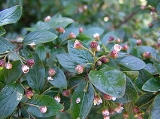
Cotoneaster lucidus
Encyclopedia
Cotoneaster lucidus is a deciduous, medium-sized shrub with long, spreading branches reaching heights (and breadths) of 6' to 10'. It is native to parts of northern Asia, and adapted to tolerate colder weather
(to zone 4). C. lucidus was described in 1856 by Diederich Franz Leonhard von Schlechtendal.
of C lucidus are dark green (changing yellow to red in autumn), simple, ovate, about 1" to 2.5" long and up to 1" wide, having pubescence on their undersides and growing in an alternate pattern along its stems. Branches are prune-tolerant.
s are a pale-pink, small and clustered blooming in early June. Flower buds are imbricate, appressed with loose exposed outer scales.
, about half an inch in diameter which ripens between September and October.
is tan in color, with lenticel
s on slender stems which have a pattern resembling fishbone.
, C lucidus holds up well in persistent winds thus making it a good hedging plant
. It grows particularly well in well-drained, loose soil
, but soil pH
can vary.
, leaf spot
, scale insect
s and spider mite
s.
(to zone 4). C. lucidus was described in 1856 by Diederich Franz Leonhard von Schlechtendal.
Leaves and branches
The leavesLeaf
A leaf is an organ of a vascular plant, as defined in botanical terms, and in particular in plant morphology. Foliage is a mass noun that refers to leaves as a feature of plants....
of C lucidus are dark green (changing yellow to red in autumn), simple, ovate, about 1" to 2.5" long and up to 1" wide, having pubescence on their undersides and growing in an alternate pattern along its stems. Branches are prune-tolerant.
Flowers
FlowerFlower
A flower, sometimes known as a bloom or blossom, is the reproductive structure found in flowering plants . The biological function of a flower is to effect reproduction, usually by providing a mechanism for the union of sperm with eggs...
s are a pale-pink, small and clustered blooming in early June. Flower buds are imbricate, appressed with loose exposed outer scales.
Fruit
C lucidus grows an attractive, blackish pome fruitFruit
In broad terms, a fruit is a structure of a plant that contains its seeds.The term has different meanings dependent on context. In non-technical usage, such as food preparation, fruit normally means the fleshy seed-associated structures of certain plants that are sweet and edible in the raw state,...
, about half an inch in diameter which ripens between September and October.
Bark
The barkBark
Bark is the outermost layers of stems and roots of woody plants. Plants with bark include trees, woody vines and shrubs. Bark refers to all the tissues outside of the vascular cambium and is a nontechnical term. It overlays the wood and consists of the inner bark and the outer bark. The inner...
is tan in color, with lenticel
Lenticel
A lenticel is an airy aggregation of cells within the structural surfaces of the stems, roots, and other parts of vascular plants. It functions as a pore, providing a medium for the direct exchange of gasses between the internal tissues and atmosphere, thereby bypassing the periderm, which would...
s on slender stems which have a pattern resembling fishbone.
Roots
Despite its sparse root systemRoot system
In mathematics, a root system is a configuration of vectors in a Euclidean space satisfying certain geometrical properties. The concept is fundamental in the theory of Lie groups and Lie algebras...
, C lucidus holds up well in persistent winds thus making it a good hedging plant
Hedge
Hedge may refer to:* Hedge or hedgerow, line of closely spaced shrubs planted to act as a barrier* Hedge , investment made to limit loss* Hedge , intentionally non-committal or ambiguous sentence fragments-See also:...
. It grows particularly well in well-drained, loose soil
Soil
Soil is a natural body consisting of layers of mineral constituents of variable thicknesses, which differ from the parent materials in their morphological, physical, chemical, and mineralogical characteristics...
, but soil pH
PH
In chemistry, pH is a measure of the acidity or basicity of an aqueous solution. Pure water is said to be neutral, with a pH close to 7.0 at . Solutions with a pH less than 7 are said to be acidic and solutions with a pH greater than 7 are basic or alkaline...
can vary.
Propagation
C lucidus can be propagated by cuttings or by seed, with stratification necessary in the case of the latter.Pests
C lucidus is prone to fireblightFireblight
Fire blight, also written fireblight, is a contagious disease affecting apples, pears, and some other members of the family Rosaceae. It is a serious concern to producers of apples and pears...
, leaf spot
Leaf spot
Leaf spots are round blemishes found on the leaves of many species of plants, mostly caused by parasitic fungi or bacteria.A typical spot is "zonal", meaning it has a definite edge and often has a darker border. When lots of spots are present, they can grow together and become a blight or a blotch...
, scale insect
Scale insect
The scale insects are small insects of the order Hemiptera, generally classified as the superfamily Coccoidea. There are about 8,000 species of scale insects.-Ecology:...
s and spider mite
Spider mite
Spider mites are members of the Acari family Tetranychidae, which includes about 1,200 species. They generally live on the under sides of leaves of plants, where they may spin protective silk webs, and they can cause damage by puncturing the plant cells to feed...
s.

